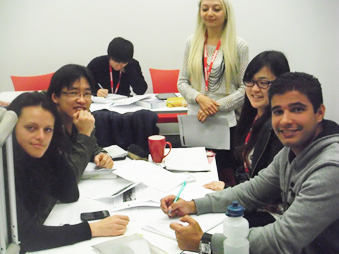I am very far from being a fluent Japanese speaker. In fact, after four years of hard study and living in the country (mainly Osaka, and Hokkaido), I was still probably only about B2 level. However, if you happened to hear me chatting to a taxi driver in Japanese, you’d probably conclude I was pretty fluent.
I was very good indeed at the basic chitchat of where are you from, how long have you been in Japan, what do you think about Osaka and so on. And the reason I became so fluent in this context? ….I kept myself engaged in a lot of general conversations with the people around me. This is where General Japanese is so beneficial, because I can perform daily things (like open a bank account), and talk about daily things (like the weather) with the people I met with daily.
Then it hit me one day – I couldn’t learn anything more than what I was using. I was striving for harder words, more unique expressions…. I couldn’t get anything new at all to stimulate my senses. I was going crazy, and giving my Japanese husband a hard time!
I returned to study in Brisbane, Australia and I did Advanced General Japanese, and then Business Japanese at Griffith University. But it felt like revision, and perhaps a bit more vocab that could help me read the Asahi newspaper, or the odd cookbook. I realised this is where Academic English is so important for international students in Australia. Not only does Academic English provide you the skills to embark on tertiary study, it can give you a better understanding of the more demanding and complex topics that general English could never provide.
In 2010, I was teaching an academic listening lesson to my Level 2 (pre-int) students on “Art Forgery”. Sounds difficult for that level right? ….Wrong! The class loved it. In fact, it wasn’t the tonnes of vocab we had to go through, or the stiff British accent the lecturer had whilst my Academic students tried to answer T/F statements. It was the linguistic components that the students were striving for.

The Linguistic components that academic students learn to become aware of can be categorised in 5 areas:
-
The Phonological component – understanding phonological (sound) features of Academic English; this includes spelling (i.e. advice, advise) intonation, stress, and sound patterns (e.g., ‘photograph, pho’tographer, pho’tography, photo’graphic)
-
The Lexical component – understanding the forms and meanings of words that are used across many different kinds of disciplines (usually an academic student favourite); as well as understanding prefixes, roots, and suffixes, the parts of speech of words (noun/verb/adverb/determiner etc.) and their grammatical limitations.
-
The Grammatical component – Here academic students guide themselves to understand and use the grammatical features (morphological and syntactic) associated with study patterns dealing with “analysis”, “definition”, “argumentative composition”, and ” procedural description”; here we learn more about grammatical metaphor as well as the complex punctuation rules that govern them (e.g. let’s eat grandma vs. let’s eat, grandma)
-
The Sociolinguistic component – This includes knowledge beyond ordinary General English examples, such as apologizing, complaining, and making requests. In Academic, students deal more with expository and argumentative texts and contexts, especially when wanting to communicate successfully with likeminded people, whether it be with their classmates in the class, or outside with native speakers.
-
And finally, The Discourse component – understanding helpful language tools such as transitions (linking words) and other organisational signals that, in reading, help academic students gain perspective on – what is being read, in seeing relationships between the writer and the reader and the listener and speaker, as well as following logical methods of thought. Particularly in writing, these discourse features help your everyday academic student develop their thesis and provide a smooth writing flow between ideas (using such words as, nevertheless, in spite of, according to)
So, as we can see, the learning patterns of Academic English are rather uniquely different to General. And I would stress that I would also like to change the term ‘General English’ to ‘Social English’ or ‘Conversational English’, because that is what it really is at the end of the day. For most students starting to study any new language this would fundamentally be enough. But it can be quite limiting, as I have experienced with my Japanese plateauing in the midst of some kind of language acquisition Death Valley.
.jpg)
Ultimately, I hope this small piece of information can help both teachers and students alike understand more about this ‘special side of the English language’ at all levels; thus, incorporating this knowledge into the classroom, as this would, more importantly, better serve the interests of second language learners who are hungry for that little bit extra.
P.S: To Australian universities out there, please open up Academic Japanese Courses for students like me.
Warm regards,
Lyn Browns